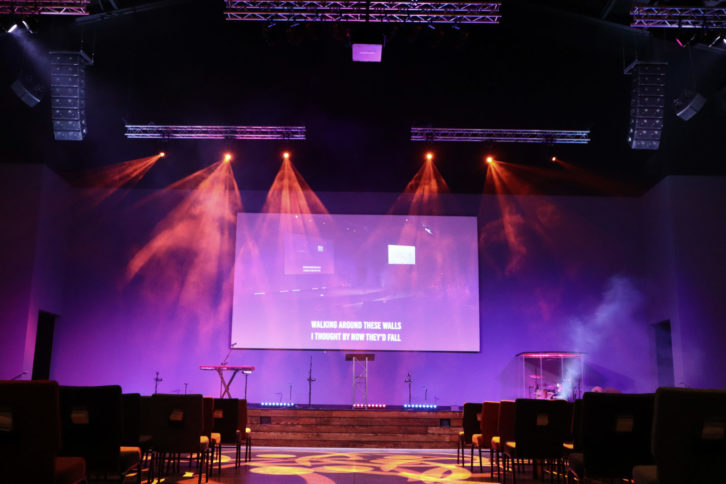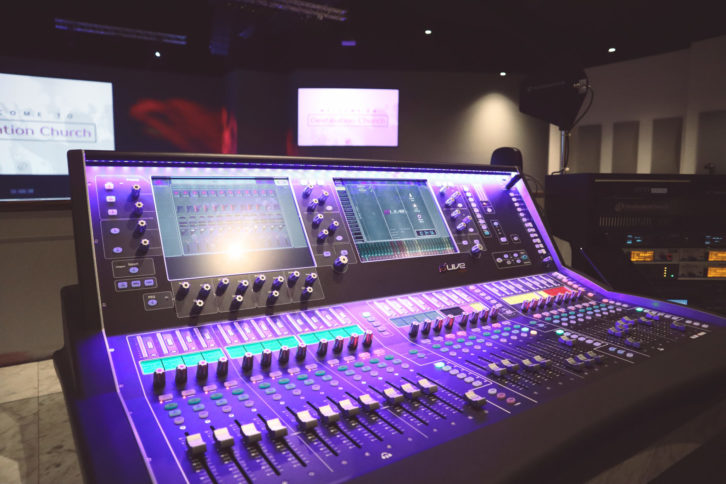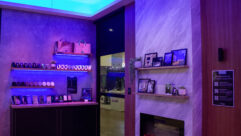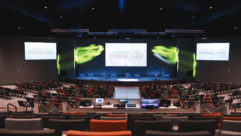 On this edition of the SVC Podcast, Contributing Editor Bennett Liles wraps up his talk with Michael Evans of Alpha Sound & Lighting about how they completely outfitted the new sanctuary at the Destination Church in Saraland, Alabama. Michael provides details on the acoustics in the sanctuary and he outlines the projection, screens, lighting and power for the new facility which now seats 1250 members and includes a performing stage for the praise band.
On this edition of the SVC Podcast, Contributing Editor Bennett Liles wraps up his talk with Michael Evans of Alpha Sound & Lighting about how they completely outfitted the new sanctuary at the Destination Church in Saraland, Alabama. Michael provides details on the acoustics in the sanctuary and he outlines the projection, screens, lighting and power for the new facility which now seats 1250 members and includes a performing stage for the praise band.
FOR MORE: GO TO PART 1
Links:
- Da-Lite DA-Mat Screens
- Elation Lighting Show Designer 2
- QSC PLX2 Series amplifiers
- Walthall & Associates acoustical consulting
When a church comes to making a big investment in sound, light and video it’s all about who you trust. The Destination Church in Saraland, Alabama relied on an old friend in Alpha Sound & Lighting and now they have the perfect setup for their new sanctuary. Michael Evans is back to tell us how he solved the lighting, video and sound, coming up next on the SVC Podcast.
Michael, good to have you back with us on the SVC Podcast from Alpha Sound and Lighting in Satsuma, Alabama.
Yes, sir, that is correct. Good to be here. Thank you, sir, for inviting us.
And so we were talking about the Destination Church which you did the whole AV system on. They have a new facility and your guys did the whole thing with sound, lighting, video and everything so let’s talk a little bit about the acoustics in that place. You said before that it’s a big metal building so did you have to do any kind of acoustic treatment or anything in there?
Well, actually what I did, I incorporated the services of Chuck Walthall of Walthall and Associates out of Pensacola, Florida. I had him to do a study on the actual facility before it was built and at that point we figured out what reverb time we wanted in the room so that the room would actually behave. And Mr. Walthall laid out that complete spec for the church. So yes, we did do acoustical treatment on the side walls, the back walls and so forth. The room behaves extremely well, especially high SPL music, yes. [Timestamp: 1:36]
Well, yeah. You would have to have something like that or you’re just going to be blasting everybody out of the place.
Absolutely.
Yes, speech intelligibility would be a problem without that, too.
Correct.

You also did the lighting so what sort of a lighting system did you put in for them? Are there a lot of lighting changes they do?
Yes. Like I said they’re very aggressive with everything they do, as I said last week. And I actually had my head lighting tech at Alpha there, Kenny Stewart, to set up the lighting system. The lighting system is all Chauvet and basically what we have is we have out front, we have three 20-foot trusses. On those trusses we used all Chauvet products. We used 24 Colorado Quad Zoom 2’s out front and then behind the stage, over the back part of the stage, we have two 20-foot trusses and back there we have six Rogue R2 spots, movers which gives us the capability of doing some effects on both side walls, on the floor, so forth and so on. And then we’re using some Chauvet up lighting, some strip lights on either side of the screen there in order to create some more looks on the stage. Yeah, the lighting system is quite extensive. It’s all being controlled by an Elation Show Designer 2CF is how it’s set up. [Timestamp: 2:49]
OK and I guess one of the tricks on this, since they have a lot of projection in there is to keep the lighting off of the projection screens which are quite large.
Yeah. We have two screens left and right, which are Da-Lite 16 x 9 Da-Mats. And then the screen in the center is built by a company out of Canada called Strong/MDI. That screen is 25 feet wide, 14 feet tall, but when you have that much area to work with, Bennett, it’s really kind of easy to be able to light the area and not get a little washed on the screens. Here again, the key there was Kenny used the Quad Zooms on the front truss so we can zoom the beam down if we need to, to get it real tight. And then the movers on the back are obviously not facing the screen so we can use them on the side walls and keep them off the screens. So we had a lot of area to work with that facilitated not having a problem there. [Timestamp: 3:41]
And the projectors there are obviously going to be used quite a bit so they’ve got to be reliable and easy to maintain so which projectors did you decide to go with?
Well, we actually used two different manufacturers. The two side projectors are both Eiki 10,000 lumen laser light projectors and then the center projector is a Digital Projection. It’s a 18,000 lumen digital projector. All worked out quite well. [Timestamp: 4:05]
Sounds like it and that center screen, from the pictures I saw, is huge. As you said, you really can’t miss that thing. It dominates the whole stage.
It’s a custom-built screen by a company called Strong/MDI in Canada. It’s 25 feet wide, 14 feet tall. It’s built on a flat truss frame. It’s mounted to that back wall about eight feet off the stage floor. [Timestamp: 4:29]
And how do you get the video signals conveyed to the projectors? Is that just HDMI extension or HDBaseT?
We’re going HDMI by SDI is what we’re doing. We’re doing an SDI digital cable to all three projectors and it’s all being facilitated and switched by a Roland switcher. But everything is HDMI but we’re taking SDI to it and turning it around. [Timestamp: 4:53]
And since you got in on the very beginning of this facility, how did you manage to plan the power? I know a lot of churches when they add things onto an older building you end up getting interference from other equipment in the form of buzz and hum in the audio so how did you manage to avoid that?
Again, I go back to Mr. Chuck Walthall of Walthall & Associates. I incorporated him to help me with that as well. And basically we have an isolation transformer that is used for all the AVL independent. In other words, it has its own independent grounding system and all the breakers and everything come through that grounding device to help prevent this problem. We absolutely had zero issues with ground hum or ground loops or anything simply because we iso’d everything from the AVL side. [Timestamp: 5:37]
And they have video cameras there in the church.
Yes, sir. They actually own their own cameras. They have three manned cameras. They owned that at the other facility and were utilizing them over there. And we just helped by bringing them over to the new facility and wired them in for them. It does interface with the existing video system for IMAG, but the actual camera system was already in place. We just moved it to the new location. [Timestamp: 6:01]
What do they do with the video? Do they do live streaming or record the services?
Both. They do live streaming on their web site as well as Facebook, and they record their services as well. Plus they do a lot of in-house promotional commercials that they put out on their web site. So yeah, they use it quite extensively. [Timestamp: 6:18]
OK and from the pictures I saw, there’s a lot going on in that church and a lot of equipment to maintain.
Yes, sir.
And if you get the wrong gear in there it’s going to be a long series of headaches.
I’m afraid so. You’re right.
How have they done with training people on the AV operation side of it?
Well here again that’s the beauty of Kyle Wilson, the worship leader there. Here again he’s extremely tech-savvy. As far as the S5000 I will tell you we’ve learned this in the church market because we do quite a lot of churches, we had the front-of-house guy start watching YouTube videos on the S5000 as far as training, and we started him doing this probably six to eight months prior to the entry to the facility so he had a great idea of what to do with the S5000 before we ever got there. And then we, in turn, did training on it at the end. That being said, Kyle Wilson trains his people constantly because he has a great group of volunteers. When you have that many people at your access, Bennett, it’s easy to find a lot of volunteers. He constantly trains his people so yes, we did do some training, but I have to give Kyle Wilson the credit for continually keeping that running. [Timestamp: 7:27]
Well, it sounds like that wasn’t too hard to do so what was the most difficult part of this whole project?
[Laughs] The most difficult part of this project was I had also incorporate Mr. Walthall of Walthall & Associates to draw all the conduit runs for all the audio and video and stage lighting that we needed. Obviously the architect and the electrical engineer didn’t feel it necessary to apply those to the drawings. We basically ended up with no conduit. We had to try to figure out how to free-run the majority of that cable. And you talk about a challenge in a building that large – that was a major challenge. We did it. I’m not sure sometimes how we did it, but we did it. But that was the biggest major challenge right there. It really, really stressed us out. [Timestamp: 8:10]
But it sounds like you managed to get on top of it and got the job done so have they got more upgrades planned for you to do?
Actually I was just over there last week. They’re in the process now of creating a new middle school and children’s worship area, which they already have but they’ve outgrown them. So they’re making them larger and I was involved with Kyle with meetings on new audio and stage lighting for those two areas. So yeah, they’re continually moving forward and utilizing their space properly. [Timestamp; 8:40]
So with Alpha Sound and Lighting what else do you have coming up?
We’re working on one right now that we originally installed in ’95 at the Forest Hill Church of God there in Mobile. And obviously being in ’95 it’s quite an old system. It’s been through some changes. It doesn’t have the newer technology in there. The electronics is very tired in that facility and they’re still using analog stuff. We’re in the process now of going to that facility and taking all that out and redoing that complete facility. That’s the third facility that we have done in the early 90’s and late 80’s that we’re now redoing. [Timestamp: 9:15]
Well, you can’t come in there and tell them that they guys who installed the previous old system didn’t know what they were doing.
[Laughs] Exactly. If I did I’d be shooting myself in the foot, I can assure of that.
Alright well it’s always good to hear about a total AV project that works out so well for a dynamic church. The Destination Church in Saraland, Alabama and Alpha Sound and Lighting handled the whole new AV system from the ground up. We’ve been talking to Michael Evans from that outfit. Nice having you here, Mike.
Thank you, Bennett. I appreciate this opportunity, okay, sir?
Alright.
The Destination Church got just what they needed with Alpha Sound & Lighting charting the course for their AV system. Next week we’ll have another AV installation story with all the angles, so get back with us then for the SVC Podcast.










